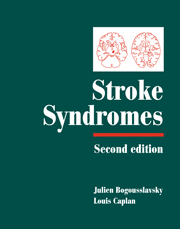Book contents
- Frontmatter
- Contents
- List of contributors
- Preface
- PART I CLINICAL MANIFESTATIONS
- PART II VASCULAR TOPOGRAPHIC SYNDROMES
- 29 Arterial territories of human brain
- 30 Superficial middle cerebral artery syndromes
- 31 Lenticulostriate arteries
- 32 Anterior cerebral artery
- 33 Anterior choroidal artery territory infarcts
- 34 Thalamic infarcts and hemorrhages
- 35 Caudate infarcts and hemorrhages
- 36 Posterior cerebral artery
- 37 Large and panhemispheric infarcts
- 38 Multiple, multilevel and bihemispheric infarcts
- 39 Midbrain infarcts
- 40 Pontine infarcts and hemorrhages
- 41 Medullary infarcts and hemorrhages
- 42 Cerebellar stroke syndromes
- 43 Extended infarcts in the posterior circulation (brainstem/cerebellum)
- 44 Border zone infarcts
- 45 Classical lacunar syndromes
- 46 Putaminal hemorrhages
- 47 Lobar hemorrhages
- 48 Intraventricular hemorrhages
- 49 Subarachnoid hemorrhage syndromes
- 50 Brain venous thrombosis syndromes
- 51 Carotid occlusion syndromes
- 52 Cervical artery dissection syndromes
- 53 Syndromes related to large artery thromboembolism within the vertebrobasilar system
- 54 Spinal stroke syndromes
- Index
- Plate section
49 - Subarachnoid hemorrhage syndromes
from PART II - VASCULAR TOPOGRAPHIC SYNDROMES
Published online by Cambridge University Press: 17 May 2010
- Frontmatter
- Contents
- List of contributors
- Preface
- PART I CLINICAL MANIFESTATIONS
- PART II VASCULAR TOPOGRAPHIC SYNDROMES
- 29 Arterial territories of human brain
- 30 Superficial middle cerebral artery syndromes
- 31 Lenticulostriate arteries
- 32 Anterior cerebral artery
- 33 Anterior choroidal artery territory infarcts
- 34 Thalamic infarcts and hemorrhages
- 35 Caudate infarcts and hemorrhages
- 36 Posterior cerebral artery
- 37 Large and panhemispheric infarcts
- 38 Multiple, multilevel and bihemispheric infarcts
- 39 Midbrain infarcts
- 40 Pontine infarcts and hemorrhages
- 41 Medullary infarcts and hemorrhages
- 42 Cerebellar stroke syndromes
- 43 Extended infarcts in the posterior circulation (brainstem/cerebellum)
- 44 Border zone infarcts
- 45 Classical lacunar syndromes
- 46 Putaminal hemorrhages
- 47 Lobar hemorrhages
- 48 Intraventricular hemorrhages
- 49 Subarachnoid hemorrhage syndromes
- 50 Brain venous thrombosis syndromes
- 51 Carotid occlusion syndromes
- 52 Cervical artery dissection syndromes
- 53 Syndromes related to large artery thromboembolism within the vertebrobasilar system
- 54 Spinal stroke syndromes
- Index
- Plate section
Summary
Causes of subarachnoid hemorrhage
It is not the purpose of this chapter to go into great depth about the variety of disease conditions that may cause subarachnoid hemorrhage, but we should like to point out that 15% of spontaneous hemorrhages in the subarachnoid space are not caused by aneurysms (Table 49.1), and that certain elements of the history or the physical examination may sometimes point to one of these specific causes.
History
Sudden headache
The key feature in diagnosing subarachnoid hemorrhage (SAH) is the history of sudden, severe and unusual headache. Classically it comes on in seconds (‘a flash’, ‘just like that’, ‘a bolt from a blue sky’, ‘as if I was hit on the head’), or in a few minutes at most. A potential pitfall is that patients may sometimes use the word ‘sudden’ to describe an episode of headache that came on in half an hour or longer, depending on the interval after which the history is given. And, even if the headache really comes on within seconds or minutes, such a history is not specific for ruptured aneurysms or even for SAH in general. Sudden onset headache may also occur with other intracranial hemorrhages, with non-hemorrhagic brain disease, and especially with innocuous forms of ‘thunderclap headache’: variants of vascular headache, migrainous or not, or of muscle contraction headache. Sexual activity may precipitate not only SAH, but also either type of the relatively harmless headaches (Lance, 1976; Pascual et al., 1996).
In general practice, exceptional forms of common headaches outnumber common forms of a rare disease, in this case a ruptured aneurysm.
- Type
- Chapter
- Information
- Stroke Syndromes , pp. 618 - 625Publisher: Cambridge University PressPrint publication year: 2001



